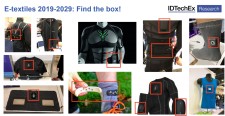IDTechEx Research Discusses Design Considerations for Electronic Textiles

BOSTON, July 8, 2019 (Newswire.com) - Commercial efforts around electronic textiles have been prominent for at least 25 years, starting with early patents and then early products throughout the 1990s. IDTechEx's latest research report in the area “E-Textiles 2019-2029: Technologies, Markets and Players,” looks at how e-textile products have changed over time, both in terms of the hardware and the more general business model.
Electronic components including batteries, transistors/microprocessors, antennae for communication and so on, have all been demonstrated in a textile format, and examples of these are included in the IDTechEx report. The majority of these demonstrations are a one-off proof of concept, and certainly not commercially mature enough for wider deployment. Therefore, as nearly all e-textile products will need these components, commercial options today typically include traditional rechargeable batteries and housed PCBs containing the other essential electronic components. The result is that these components need to be housed somewhere in the e-textile product, and hence it is typically possible to "find the box" which contains these components.
This electronic box can potentially be a good solution to the challenge of washing. Typically, e-textile products can be sold with multiple versions of the garment element and a single box to fit all of them. Then the box can be removed for washing and replaced onto copies of the garment element, just as would be the case for a smartwatch or chest strap. This requires a replaceable, reliable, durable and fool-proof connector option, for which traditional snap fasteners or magnetic versions are typically preferred. The IDTechEx research report looks at connector options for e-textiles in detail, concluding that the industry has finally started to converge towards some design standards after years of divergent approaches.
However, the case persists that the presence of these boxes remains a barrier towards increasingly widespread adoption. The boxes can be impractical, uncomfortable, unattractive, and therefore an unwelcome, if necessary, hindrance to the overall product. This said, e-textile product designers continue to improve these systems, making the boxes less visible, more practical and overall minimizing any negative aspects that their presence may create.
Some products have been demonstrated that can begin to move towards an option without a box. Some groups have demonstrated integration of electronic components directly into yarns; where components are small enough, they can be encased and connected, allowing integration of various sensor types. However, this is size limited, so unlikely to be feasible for larger components such as the battery. Nonetheless, this has been an interesting trend, and is covered in the report with several case studies (e.g. discussing work from Primo1D, Siren Care, Nottingham Trent University, and others).
Another idea to remove the box would be to minimize the volume that needs to be taken up by batteries. This could be done by reducing the overall power consumption of the system, or by providing additional power to the device via a technique such as energy harvesting or wireless charging. Many of these ideas have been considered by e-textile companies. The report describes several techniques for energy harvesting in e-textiles, most of which are academic proof-of-concept so far, but some of which have been explored in a more commercial context. Similarly, wireless charging techniques, including RF charging, inductive charging, and so on, have also been explored by different companies in the space, and some examples of proposed partnerships and approaches are mentioned in the report.
A quarter of a century of commercial exploration around e-textiles has resulted in many companies that exist to serve this space, but still, the products remain outside of mainstream markets. As part of this report, IDTechEx Research has listed 200 players involved in this industry, spanning the entire value chain. The report is written to provide the most comprehensive overview of this emerging technology space, enabling readers to learn from the past, assess partners or competitors in the present, and plan for the future of this industry. For more information about the report, see the report “E-Textiles 2019-2029: Technologies, Markets and Players” or email research@idtechex.com.
IDTechEx guides your strategic business decisions through its Research, Consultancy and Event products, helping you profit from emerging technologies. For more information on IDTechEx Research and Consultancy contact research@IDTechEx.com or visit www.IDTechEx.com.
To find out more about Wearable Technology research available from IDTechEx visit www.IDTechEx.com/WT or to connect with others on this topic, IDTechEx Events is hosting: Healthcare Sensor Innovations 2019 Conference on 25 - 26 September 2019 at Cambridge, UK. Please visit www.IDTechEx.com/Cambridge.
Media Contact:
Jessica Abineri
Marketing Assistant
+44(0)1223 812300
Source: IDTechEx